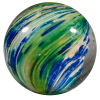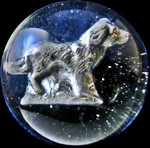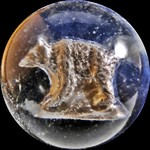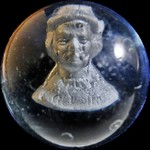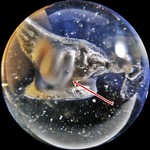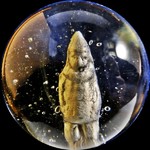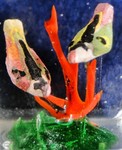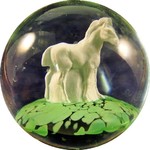SULPHIDES
A Sulphide has a transparent base with a sulphide figure inserted inside it. They are single-gather, single-pontil marbles.
The most common figure found in a Sulphide marble is an animal. Barnyard animals, household pets, squirrels, and birds are most common. Wild animals including
razorbacks, elephants, and lions are a little less common.
Click any marble to see a full-screen image.
Human figures are more difficult to find. These can be either full length figures, or busts. Generally, they are historical.
Mythical or allegorical figures are rarer still, as are angels. It is generally believed that angels are mourning or remembrance pieces. Angels come in a variety
of styles.
There is a series of Sulphide marbles that contain the individual numerals 0 to 9.
There are also Sulphide marbles with figures of inanimate objects in them. These are usually coins, numerals on disks or pocket watches. They are extremely rare.
Some sulphide figures are painted. We have seen figures that are painted (simply or elaborately), as well as painted numerals and inanimate objects. The value of these is greatly affected by the degree of color coverage, the brightness of the colors, and the number of colors used.
A very few sulphide figures have been found in transparent colored glass. A number of shades have been found, including blues, greens, yellows, amethysts, browns, and pinks. These
are very rare.
Also, an extremely few Sulphides have been found with more than one figure in them. These are also extremely rare.
The value of a Sulphide is greatly affected by several factors, other than the type of figure in the marble. Because the figures were inserted into the glass by hand, the skill of the maker greatly affected the quality of the marble.
Figures that are off-center in the marble can be greatly discounted in value (by as much as 50% or more). A figure can either be too close to the right or left
side of the marble, too high or low, or set too far forward or back.
The figure had to be heated to the same temperature as the glass on the end of the punty, in order for the marble
to be made properly. If the temperature difference between the glass and the figure was too great, then the marble would shatter when it
was being made. In some cases, the temperature difference was not so great that the marble would shatter, but rather the figure would crack when inserted.
Cracked figures discount the value of the marble (by up to 50%). In other cases, pieces of the figure broke off when it was inserted into the
glass. This also discounts the value.
In some cases, as the figure was being inserted into the marble, some air would be trapped in the marble as well. A thin layer of trapped air around the figure was
necessary to achieve a silvery sheen that enhances the viewing of the figure. However, too much trapped air can cause so much reflection that the figure cannot be
properly seen. Trapped air can discount the value of the marble by as much as 60%.
Finally, because Sulphides are single-pontil marbles, there is always one pontil on the surface. In some cases, this pontil is ground down. If the pontil is on the bottom pole of the marble, then the figure can be viewed properly from all angles. However, depending on the skill of the maker, the pontil could end up anywhere on the marble in relation to the figure. In some instances, the pontil obscures viewing one side of the figure. This can result in a discount on the value of the marble (up to 40%).
In 1993, a group of Sulphides surfaced that have become the source of great controversy in the marble collecting community. These marbles have been dubbed “California Sulphides” because
there was only one person who was selling them, and he was from California. Without getting into the whole history of the events surrounding the introduction
of these marbles to the market, it is safe to say that the marble collecting community has been pretty much divided as to whether these marbles are as old as traditionally known sulphides, or
are modern reproductions, or are older but not as old as antique Sulphides. You must reach your own conclusions as to the age of these
marbles.
They can be identified by several features. Many of them were in colored glass (usually very dark) or a light Vaseline color. Many contained multiple figures (two
or more). Many were figures that had never been seen before (seahorse, lady riding a horse side-saddle, etc.). None of the figures had a silvery sheen to them, and
many had a light rust-red haze on them. Very few of the marbles fluoresced under a black light (traditional sulphides usually fluoresce). Many had either a polished surface or an unpolished
surface that had many tiny fissures in it when viewed by a 10x lens.
There are some Sulphides that have appeared with crudely painted birds in them, usually on colored glass branches. These are definitively identified as Chinese, as
the same figures exist in Chinese paperweights. They are believed to be from the 1960s and 1970s.
Finally, a set of numerals, 0 to 9, was produced by an Italian glass house in the late 1960s and brought to the U.S. by a New York importer. They are easily identifiable as contemporary


